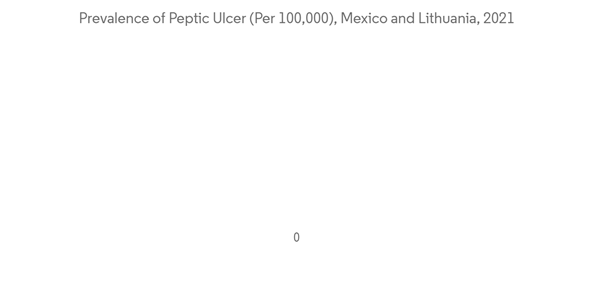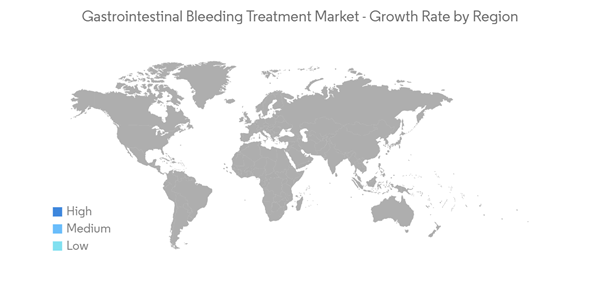The COVID-19 pandemic had an adverse effect on the market. An article published in the National Library of Medicine in February 2021 reported that flexible endoscopy plays a major role in cancer screening, surveillance, and treatment programs. Due to the risk of COVID-19 transmission to healthcare workers, most healthcare facilities halted non-emergency and diagnostic procedures during the lockdown. The halting of procedures during the time of COVID-19 impacted the growth of the market. However, the market is anticipated to gain traction over the coming years owing to the resumption of diagnosis and treatment procedures globally. Furthermore, initiatives such as product launches are expected to increase market growth. For instance, in October 2021, FUJIFILM Healthcare Americas Corporation launched the El-740D/S dual-channel flexible endoscope. It is one of the first dual-channel endoscopes that has received approval from the United States Food and Drug Administration (FDA) for use in both upper and lower gastrointestinal applications. Such approvals from the regulatory authority to technically advanced and wide-application gastroscopes are also fostering the growth of the market segment.
Gastrointestinal bleeding refers to blood loss that occurs within the digestive organs. The high prevalence of upper gastrointestinal bleeding, the rise in applications of endoscopic hemostasis, and the growing geriatric population are the main factors that are boosting the growth of the gastrointestinal bleeding treatment market. Factors such as the growing burden of gastric cancers, tumors, and other chronic diseases, advancement in technology, and the launch of products are driving the growth of the market segment. According to the Centers for Disease Control and Prevention, in 2021, the number of adults diagnosed with ulcers in the United States was 14.8 million, with the percentage of adults diagnosed being merely 5.9%. Many governments, including the ones of developing countries, are taking initiatives to increase the diagnosis of these diseases.
Initiatives by key market players are another factor in market growth. For instance, in October 2021, FUJIFILM Healthcare Americas Corporation exhibited its full line of solutions for gastroenterologists at the annual convention of the American College of Gastroenterology (ACG) booth 1323 in Las Vegas on October 22-27. Similarly, in March 2021, Fujifilm Healthcare started operating as a fully owned subsidiary of FUJIFILM and completed the acquisition of the diagnostic imaging-related business of Hitachi Ltd. Thus, the increasing prevalence of diseases, coupled with initiatives by key market players, is expected to help the market growth.
However, the dearth of skilled labor is expected to restrain the growth of the market in the forecast period.
Gastrointestinal Bleeding Treatment Market Trends
Upper GI Tract Segment is Expected to Register a Good Growth Over the Forecast Period
By GI tract division, the market has been segmented into Upper GI Tract and Lower GI Tract. The upper GI tract accounted for a significant growth in the gastrointestinal bleeding treatment market, and this trend is likely to continue during the forecast period. A peptic ulcer is one of the most common causes of upper GI tract bleeding and is known to have increased prevalence owing to an increase in H. pylori infection. Irrespective of any region, peptic ulcer cases are quite common because of unhealthy diet habits across the world. Furthermore, other gastric diseases, such as Peptic Ulcer (PUD), are increasing worldwide, which is augmenting the demand for gastrointestinal devices. For instance, the National Institute of Health report published in June 2022 stated that in Mexico and Lithuania, the incidence of PUD hospitalizations was predicted to be between 3.5 and 92.1 per 100,000 people in 2021. Additionally, in 2021, it was anticipated that 329,000 people would be hospitalized for PUD across the OECD's 36 member countries. Thus, the increasing prevalence of GI disorders is expected to increase the market growth.The approval of new products by different regulatory authorities is driving the growth of the market segment. For instance, in February 2022, Ambu received 510(k) regulatory clearance from the United States Food and Drug Administration for Ambu aScope Gastro and Ambu aBox 2 in the United States. aScope Gastro is Ambu's one of the first sterile single-use gastroscopes and includes new advanced imaging and design features in a combined solution with next-generation display and processor technology. With HD capabilities, the aBox 2 will set a new benchmark in terms of image quality and will be at the center of Ambu's endoscopy ecosystem. Such approvals are propelling the growth of the market segment. Thus, the increasing prevalence of diseases coupled with product approval is expected to increase segmental growth over the forecast period.
North America is Expected to Have Significant Share in the Gastrointestinal Bleeding Treatment Market
North America leads the market owing to the upsurge in the demand for advanced treatment options and the prevalence of upper gastrointestinal bleeding. The American Cancer Society article updated in January 2021 reported that in 2021, there were an estimated 104,270 new cases of colon cancer and 45,230 new cases of rectal cancer diagnosed in the United States. The same source also reported that overall, the lifetime risk of developing colorectal cancer is about 1 in 23 (4.3%) for men and 1 in 25 (4.0%) for women. Thus, a growing burden of such patients is being observed approaching the hospitals for better treatment, particularly during the advanced stage of the disease. This drives the market for gastrointestinal bleeding treatment.Clinical trials are another factor in market growth. For instance, in March 2022, Medtronic PLC released the final findings from a randomized, international, multicenter study that confirmed the effectiveness of the GI Genius intelligent endoscopy module, which uses AI as an aid in detecting colorectal polyps during colonoscopy, potentially helping to prevent colorectal cancer (CRC). The study showed that the use of GI Genius in conjunction with colonoscopy significantly decreases the miss rate (2x) of colorectal polyps and adenomas compared to standard colonoscopy. Thus, such clinical trials are expected to increase the adoption of such devices, which is expected to increase the market growth.
Thus, the prevalence of such diseases in the region, coupled with the research studies, is expected to increase market growth over the forecast period.
Gastrointestinal Bleeding Treatment Industry Overview
The Gastrointestinal Bleeding Treatment Market is moderately fragmented. The major players in the gastrointestinal bleeding treatment market include Boston Scientific Corporation, CONMED Corporation, Cook Group, ERBE Elektromedizin GmbH, Olympus Corporation, Ovesco Endoscopy AG, STERIS PLC, and US Medical Innovations.Additional Benefits:
- The market estimate (ME) sheet in Excel format
- 3 months of analyst support
This product will be delivered within 2 business days.
Table of Contents
Companies Mentioned (Partial List)
A selection of companies mentioned in this report includes, but is not limited to:
- Boston Scientific Corporation
- CONMED Corporation
- Cook Group
- ERBE Elektromedizin GmbH
- Medtronic PLC
- Olympus Corporation
- Ovesco Endoscopy AG
- Pfizer Inc.
- STERIS PLC
- US Medical Innovations










